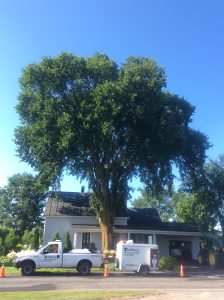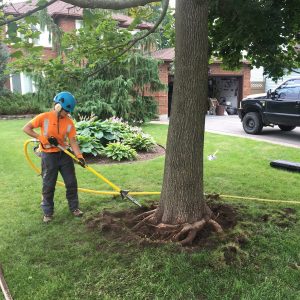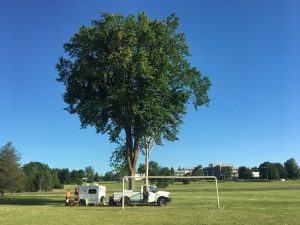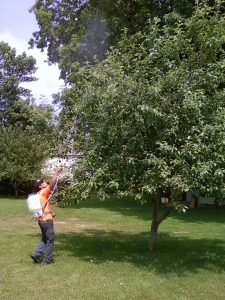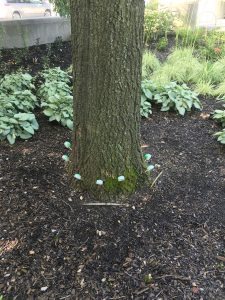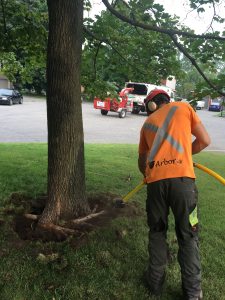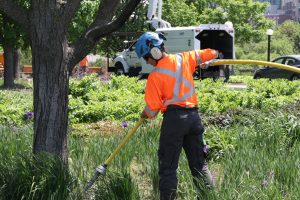Plant Health Care
WHAT IS PHYTOSANITARY CARE?
Phytosanitary care can include a variety of techniques, including:
Insecticide or fungicide application
Insecticide or fungicide application: this technique involves spraying or injecting chemicals or organic products on trees to prevent or treat diseases and pests. The chemicals used are selected according to the specific diseases and pests affecting the trees.
Introduction of beneficial insects
Beneficial insects are those insect species that provide valuable services such as pollination and pest control. These predators and parasitoids are generally larger than their prey. They are quite capable of moving around in search of food, and they usually consume a large number of insect pests in their lifetime. This is great news for gardeners and growers because it means there is an effective, non-toxic approach to solving pest problems.
Tree pruning
This technique involves removing diseased, dead or damaged branches from trees to prevent the spread of disease or pests. This technique can also help stimulate growth and improve the overall health of the tree.
Improving environmental conditions
This technique involves improving the environmental conditions around the tree to help prevent disease and pests. This may include irrigation, fertilization and management of plant debris to reduce disease proliferation.
Regular monitoring of tree health
This technique involves regularly monitoring the health of the tree to detect diseases and pests as they appear. This allows for rapid intervention to prevent the spread of disease or pests.
WHY FERTILIZE YOUR TREES?
In its natural environment, the tree benefits from nutrients from decaying leaves, dead branches and other organic matter found on the ground. Unfortunately, in urban areas, the good citizen rakes up all the leaves and cleans his property of all organic matter, thus depriving the trees of these precious nutrients. That’s why we offer a species-specific granular fertilizer. The fertilizer is applied directly to the root system and can be absorbed immediately after application. This allows the tree to better withstand adverse conditions and achieve vigorous growth. Sometimes immediate absorption of nutrients is necessary, which temporarily remedies the problem.
Fertilizing trees is important for several reasons:
Improve tree growth
Fertilizers provide essential nutrients such as nitrogen, phosphorus and potassium, which stimulate tree growth and improve health.
Enhance disease and pest resistance
Well-fertilized trees are more resistant to disease and pests. The essential nutrients help build the tree's health, making it more resistant to disease and pest attacks.
Improve soil quality
Fertilizers can improve soil quality by increasing organic matter and improving soil structure. This allows the roots to better root in the soil and absorb nutrients more efficiently.
Encourage flowering and fruiting
Fertilizers can help stimulate flowering and fruiting in trees, which can increase fruit production and other crops.
However, it is important to fertilize trees sparingly and with the right products to avoid overdosing and damage to the trees and the environment. It is recommended that a professional be consulted to assess the fertilization needs of the trees and to carry out the fertilization carefully and effectively.
WHY CALL AN ARBORIST TO DIAGNOSE A TREE INFECTION?
Your tree may be suffering from bacterial, viral or fungal infections and insect or arachnid infestations. Our arborists are able to diagnose most problems on the spot. If it is an unusual situation, we will take samples to our lab and identify most problems. If we need further investigation, we are prepared to send samples quickly to a specialized laboratory. Arboris Inc. finds answers.
Using an arborist to diagnose an infection in a tree is important for several reasons:
Skill and experience
Arborists are trained and experienced professionals in identifying tree diseases and pests. They are able to recognize the symptoms and signs that indicate infection or disease and make an accurate diagnosis.
Prevention and Treatment
An arborist can recommend preventive measures to help prevent infection and disease in trees. If an infection is already present, the arborist can recommend specific treatments to eliminate the disease and help restore the tree to health.
Quality Equipment and Products
Arborists have access to specialized equipment and quality products to diagnose and treat tree infections and diseases. They can also use safe, environmentally friendly products to avoid environmental damage.
Safety
Sick trees can be dangerous and unstable, especially if they have dead or rotting branches. Arborists have the expertise and equipment to work safely around diseased trees.
WHAT ARE THE METHODS OF INFECTION CONTROL IN A TREE?
We propose several control methods. The important thing is to know the source of the problem. If it is a fungal infection with anthracnose, a simple thinning of the crown could be the solution. An aphid infestation could be mitigated by introducing natural predators such as ladybugs or applying horticultural oil in the spring. And if you have a newly planted tree that is dying due to ongoing Japanese beetle attacks, with our licensed exterminator, we can take drastic measures to save your tree.
Common methods of infection control in a tree include:
Pruning of infected parts
Removing infected parts of the tree, such as dead or rotting branches, can help prevent the spread of infection.
Fertilization
Fertilizing the tree can help improve its health and disease resistance.
Chemical treatment
Chemicals such as fungicides can be used to treat fungal infections, while insecticides can be used to treat insect infections. It is important to use these products carefully to avoid damage to the environment and other organisms.
Biological treatment
Biological treatments, such as beneficial bacteria and fungi, can be used to control tree diseases and pests without harming the environment.
Use of insect traps
Insect traps can be used to trap and eliminate insect pests, reducing the risk of infection to the tree.
Regular pruning
Regular pruning of the tree can help improve its health and reduce the risk of infection.
The choice of infection control method depends on the specific infection and the severity of the situation. It is recommended that a professional arborist be consulted to diagnose the infection and recommend appropriate control measures to avoid damage to the tree and the environment.
HOW TO IMPROVE SOIL AND ROOTS FOR TREES?
Sometimes the soil becomes depleted of nutrients or the soil structure changes due to compaction, for example. The tree is no longer adapted to its new environment and suffers. Arboris Inc. can reverse this condition by removing the soil with compressed air and correcting the problem by adding new and improved soil. The air spade minimizes root damage and can also be used to uncover encircling roots that can be pruned to restore vascular circulation.
Improving soil and roots is important for tree health and growth. Here are some methods for doing so:
Common methods of infection control in a tree include:
Fertilization
Fertilization is important to provide essential nutrients to trees. Use a balanced fertilizer that contains nutrients such as nitrogen, phosphorus and potassium.
Soil amendment
If your soil is low in organic matter, you can amend it with compost or other organic materials. This can help improve soil structure and stimulate root growth.
Soil aeration
Soil aeration can help improve air and water circulation around tree roots, promoting their growth and health.
Mulch
Mulch is a protective layer of organic matter spread on the soil around the tree. This helps retain moisture and prevent weeds from growing, while providing additional nutrients to the roots.
Irrigation
It is important to provide sufficient water to the trees, especially when there is a prolonged drought. Regular watering can help stimulate root growth and improve the overall health of the tree.
Root pruning
Pruning problematic roots can help the tree regain control of its growth and avoid dieback.
The choice of infection control method depends on the specific infection and the severity of the situation. It is recommended that a professional arborist be consulted to diagnose the infection and recommend appropriate control measures to avoid damage to the tree and the environment.

